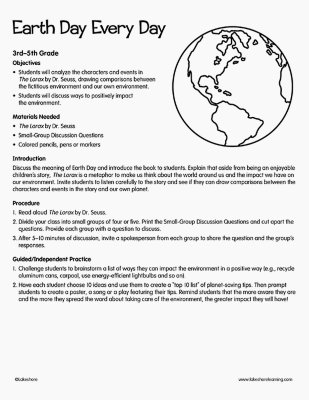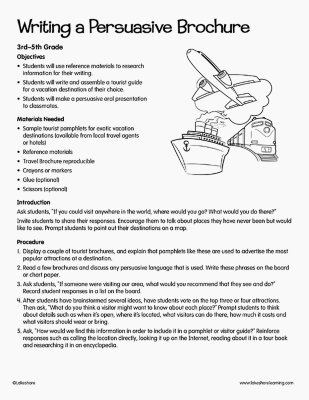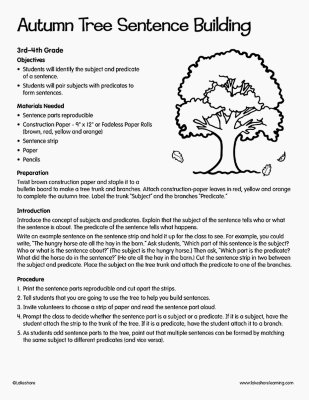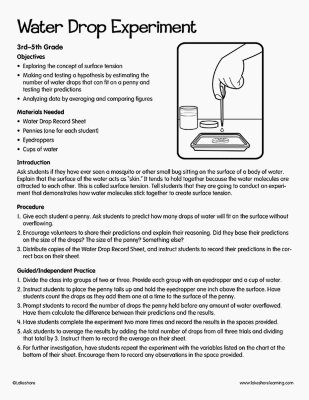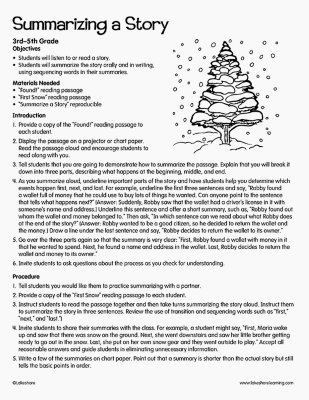Narrow by Grade
- Infant (0)
- Toddler (0)
- Preschool (0)
- Pre-K (0)
- Kindergarten (0)
- 1st (0)
- 2nd (0)
- 3rd (3)
- 4th (5)
- 5th (2)
- 6th & Up (0)
Grade
Narrow by Age
- 0-18m (1)
- 18-36m (0)
- 3 yrs. (0)
- 4 yrs. (4)
- 5 yrs. (3)
- 6 yrs. (7)
- 7 yrs. (6)
- 8 yrs. (4)
- 9 yrs. (5)
- 10 yrs. (2)
- 11 yrs. & Up (0)
Age 9 yrs.
5 results for "see"
Filters
Clear All
Earth Day Every Day
3rd Grade - 5th Grade
Objectives Students will analyze the characters and events in The Lorax by Dr. Seuss, drawing comparisons between the fictitious environment and our own environment. Students will discuss ways to positively impact the environment. Materials Needed The Lorax by Dr. Seuss Small-Group Discussion Questions Colored pencils, pens or markers Introduction Discuss the meaning of Earth Day, and introduce the book to students. Explain that aside from being an enjoyable children’s story, The Lorax is a metaphor to make us think about the world around us and the impact we have on our environment. Invite students to listen carefully to the story and see if they can draw comparisons between the characters and events in the story and our own planet.
View Lesson PlanWriting a Persuasive Brochure
3rd Grade - 5th Grade
Objectives Using reference materials to research for their writing Introducing the topic or text they are writing about, stating an opinion and creating an organizational structure that lists reasons Providing reasons that support the opinion Reporting on a topic or text, telling a story, or recounting an experience in an organized manner, using appropriate facts and relevant, descriptive details to support main ideas or themes; speaking clearly at an understandable pace Materials Needed Sample tourist pamphlets for exotic vacation destinations (available from local travel agents or hotels) Reference materials Travel Brochure reproducible Crayons or markers Glue (optional) Scissors (optional) Introduction Ask students, “If you could visit anywhere in the world, where would you go? What would you do there?” Invite students to share their responses. Encourage them to talk about places they have never been but would like to see. Prompt students to point out their destinations on a map.
View Lesson PlanAutumn Tree Sentence Building
3rd Grade - 4th Grade
Objectives Students will identify the subject and predicate of a sentence. Students will pair subjects with predicates to form sentences. Materials Needed Sentence parts reproducible Construction Paper - 9" x 12" or Fadeless Paper Rolls (brown, red, yellow and orange) Sentence strip Paper Pencils Preparation: Twist brown construction paper and staple it to a bulletin board to make a tree trunk and branches. Attach construction-paper leaves in red, yellow and orange to complete the autumn tree. Label the trunk “Subject” and the branches “Predicate.” Introduction Introduce the concept of subjects and predicates. Explain that the subject of the sentence tells who or what the sentence is about. The predicate of the sentence tells what happens. Write an example sentence on the sentence strip and hold it up for the class to see. For example, you could write, “The hungry horse ate all the hay in the barn.” Ask students, “Which part of this sentence is the subject? Who or what is the sentence about?” (The subject is the hungry horse.) Then ask, “Which part is the predicate? What did the horse do in the sentence?” (He ate all the hay in the barn.) Cut the sentence strip in two between the subject and predicate. Place the subject on the tree trunk and attach the predicate to one of the branches.
View Lesson PlanWater Drop Experiment
4th Grade
Objectives Exploring the concept of surface tension Making and testing a hypothesis by estimating the number of water drops that can fit on a penny and testing their predictions Analyzing data by averaging and comparing figures Materials Needed Water Drop Record Sheet Pennies (one for each student) Eyedroppers Cups of water Introduction Ask students if they have ever seen a mosquito or other small bug sitting on the surface of a body of water. Explain that the surface of the water acts as “skin.” It tends to hold together because the water molecules are attracted to each other. This is called surface tension. Tell students that they are going to conduct an experiment that demonstrates how water molecules stick together to create surface tension.
View Lesson PlanSummarizing a Story
4th Grade
Objectives Students will listen to or read a story. Students will summarize the story in writing, using sequencing words in their summaries. Materials Needed “Found!” reading passage “First Snow” reading passage “Summarize a Story” reproducible Introduction Provide a copy of the “Found!” reading passage to each student. Display the passage on a projector or chart paper. Read the passage aloud and encourage students to read along with you. Tell students that you are going to demonstrate how to summarize the passage. Explain that you will break it down into three parts, describing what happens at the beginning, middle, and end. As you summarize aloud, underline important parts of the story and have students help you determine which events happen first, next, and last. For example, underline the first three sentences and say, “Robby found a wallet full of money that he could use to buy lots of things he wanted. Can anyone point to the sentence that tells what happens next?” (Answer: Suddenly, Robby saw that the wallet had a driver’s license in it with someone’s name and address.) Underline this sentence and offer a short summary, such as, “Robby found out whom the wallet and money belonged to.” Then ask, “In which sentence can we read about what Robby does at the end of the story?” (Answer: Robby wanted to be a good citizen, so he decided to return the wallet and the money.) Draw a line under the last sentence and say, “Robby decides to return the wallet to its owner.” Go over the three parts again so that the summary is very clear: “First, Robby found a wallet with money in it that he wanted to spend. Next, he found a name and address in the wallet. Last, Robby decides to return the wallet and money to its owner.” Invite students to ask questions about the process as you check for understanding.
View Lesson Plan